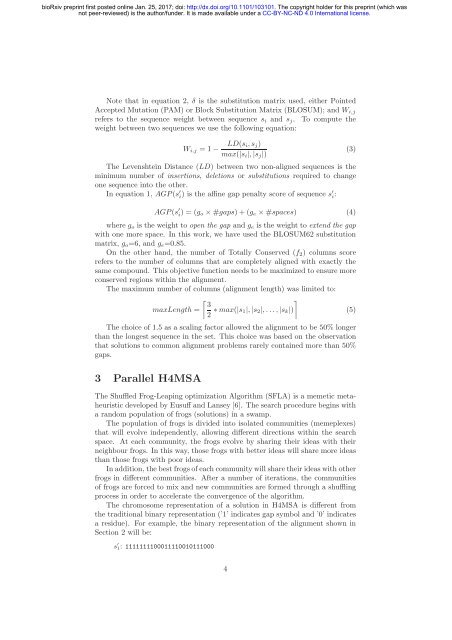different
103101.full
103101.full
You also want an ePaper? Increase the reach of your titles
YUMPU automatically turns print PDFs into web optimized ePapers that Google loves.
ioRxiv preprint first posted online Jan. 25, 2017; doi: http://dx.doi.org/10.1101/103101. The copyright holder for this preprint (which was<br />
not peer-reviewed) is the author/funder. It is made available under a CC-BY-NC-ND 4.0 International license.<br />
Note that in equation 2, δ is the substitution matrix used, either Pointed<br />
Accepted Mutation (PAM) or Block Substitution Matrix (BLOSUM); and W i,j<br />
refers to the sequence weight between sequence s i and s j . To compute the<br />
weight between two sequences we use the following equation:<br />
W i,j = 1− LD(s i,s j )<br />
max(|s i |,|s j |)<br />
The Levenshtein Distance (LD) between two non-aligned sequences is the<br />
minimum number of insertions, deletions or substitutions required to change<br />
one sequence into the other.<br />
In equation 1, AGP(s ′ i ) is the affine gap penalty score of sequence s′ i :<br />
AGP(s ′ i ) = (g o ×#gaps)+(g e ×#spaces) (4)<br />
where g o is the weight to open the gap and g e is the weight to extend the gap<br />
with one more space. In this work, we have used the BLOSUM62 substitution<br />
matrix, g o =6, and g e =0.85.<br />
On the other hand, the number of Totally Conserved (f 2 ) columns score<br />
refers to the number of columns that are completely aligned with exactly the<br />
same compound. This objective function needs to be maximized to ensure more<br />
conserved regions within the alignment.<br />
The maximum number of columns (alignment length) was limited to:<br />
⌈ ⌉<br />
3<br />
maxLength =<br />
2 ∗max(|s 1|,|s 2 |,...,|s k |) (5)<br />
The choice of 1.5 as a scaling factor allowed the alignment to be 50% longer<br />
than the longest sequence in the set. This choice was based on the observation<br />
that solutions to common alignment problems rarely contained more than 50%<br />
gaps.<br />
3 Parallel H4MSA<br />
The Shuffled Frog-Leaping optimization Algorithm (SFLA) is a memetic metaheuristic<br />
developed by Eusuff and Lansey [6]. The search procedure begins with<br />
a random population of frogs (solutions) in a swamp.<br />
The population of frogs is divided into isolated communities (memeplexes)<br />
that will evolve independently, allowing <strong>different</strong> directions within the search<br />
space. At each community, the frogs evolve by sharing their ideas with their<br />
neighbour frogs. In this way, those frogs with better ideas will share more ideas<br />
than those frogs with poor ideas.<br />
Inaddition, thebestfrogsofeachcommunitywillsharetheirideaswithother<br />
frogs in <strong>different</strong> communities. After a number of iterations, the communities<br />
of frogs are forced to mix and new communities are formed through a shuffling<br />
process in order to accelerate the convergence of the algorithm.<br />
The chromosome representation of a solution in H4MSA is <strong>different</strong> from<br />
the traditional binary representation (’1’ indicates gap symbol and ’0’ indicates<br />
a residue). For example, the binary representation of the alignment shown in<br />
Section 2 will be:<br />
s ′ 1: 1111111100011110010111000<br />
(3)<br />
4






